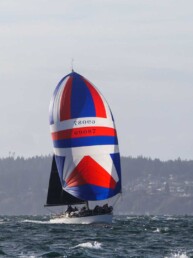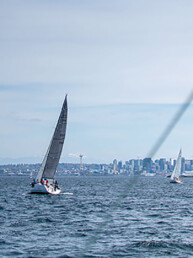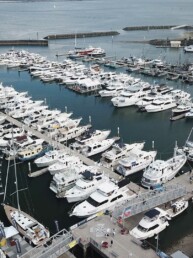When a Sailor or Three Goes in the Water, Is Your Crew Ready to Respond?
The Carol Pearl Blakely Rock Benefit Race, hosted annually by the Sloop Tavern Yacht Club (STYC), is a highlight of the spring racing season. Each year, 80-plus boats set off around Blakely Rock near Bainbridge Island and return to Shilshole. The weather this time of year is classically unpredictable, as was the case for this year’s race on April 1, 2023.
The race started with a moderate 8-12 knot southerly for the outbound leg. By the time boats had rounded Blakely Rock, the breeze had steadily increased to the low- to mid-20s — making the choice of spinnaker (which one, if any) an important decision. As many in the fleet approached West Point, the wind continued to increase and knockdown after knockdown occurred as overpowered boats struggled to maintain composure in the gusts. Some spinnakers parted ways with the boats, ending up in shreds and making sailmakers very busy. The wind had increased to sustained upper-20s with gusts into the mid-30s.
While the race continued for some of the fleet, others diverted attention from their racing fun to respond to a scary crew overboard (COB) situation.
Crew Overboard
Several minutes after a different “Man Overboard” call (see sidebar), another panicked “Crew Overboard” call came over VHF channel 16, this time reporting multiple people in the water, all from a single boat.
While attempting to douse the spinnaker and reef the main, a violent broach jolted this boat, causing the foredeck person to be pitched overboard. She was able to grab onto the lifeline momentarily and another crew member came to her aid, but was unable to hang on in the sea state.
As she fell into the water her PFD inflated, but due to its loose fit and lack of leg or crotch straps, it kept riding above her head and required great effort on her part to keep floating in the rolling waves. This situation, in addition to cold water shock, resulted in instant exhaustion.
Attempted Rescues
Other boats in the vicinity witnessed the boat’s broach and saw the COB floating. The first responding vessel tossed their LifeSling on target, but didn’t provide time for her to put it around herself before starting to pull her toward their boat, submerging her as she dragged. This added to her exhaustion, given her onset of hypothermia and fatigue from trying to fight to keep the PFD on her body.
Report from the First Person in the Water (all following quotes also from this individual):
“I was able to see them throw the LifeSling and exactly where it landed in the water, and was able to swim over to the line. The issue was I do think they started pulling way too soon, I could have at that point gotten into the LifeSling because I still had full function of all my limbs and could think clearly. Once they started pulling, I was moving fast enough in the water that no matter which way I turned, water was moving up and over my head and I couldn’t breathe. By the time I got to the boat, I was out of breath and was starting to have trouble moving because of that. I know I was having issues with my left arm, partially because I had wrapped the line around my arm because I almost lost hold of it several times as they were pulling me in, and that was the only way I felt I would stay with the LifeSling. They also started and continued to lift the LifeSling out of the water even when I was trying to tell them I wasn’t all the way in, and so I fell back in the water.”
No less than two additional boats attempted to throw or drag a LifeSling toward the person in the water, but she was cold and fatigued. One toss of the LifeSling even brought it within five feet of her, but she remained unable to move toward it due to the onset of hypothermia and loss of motor control. At this point she had been in the water an estimated 20-plus minutes.
Second COB from Original Vessel
After dousing sails and circling around back toward the scene where they’d lost their foredeck crew overboard, the original vessel circled around to find her. They had witnessed some of the previous rescue attempts, and were concerned to find that she had come out of her life vest. A fellow crew aboard (her brother) attempted to throw the LifeSling to the person in the water. She was unable to get to it on the first attempt, so he made another attempt. Unfortunately, while throwing the LifeSling the second time, the boat pitched at the same moment he threw, and the throwing crew member lost his footing and was also hurled into the cold water of Puget Sound. He was able to swim to the LifeSling and brought it over to her in the water. At the same time, he held onto her and swam as best he could toward the boat. He reached up to and wrapped his arm around the lifeline, but only briefly before the boat lurched again in the waves and both were once again in the water, separated from one another.
“I heard my brother say my name the second time he threw it and remember watching it fly through the air and land near me as I saw him do a funky cartwheel somersault thing into the water out of the corner of my eye. The entire time thinking, ‘How do I get over to the LifeSling?’ I could still kind of move my arms at that point but couldn’t do much with my legs. I felt my brother grab me, heard him say to keep my head above the water, felt something against my arms, felt a wave and he was gone.”
A Third Person in the Water
Aboard the now-shorthanded vessel, the remaining crew swung the boat around for a rescue attempt of their two crew in the water, and were able to physically grab hold of the first COB and tried to hoist her onto the boat using brute strength. This failed, so they made an attempt to connect a halyard to the LifeSling to hoist her out. The thought was to pass her the halyard, but her fingers were too numb and cold at this point, and she was unable to grab it. A crew member attempted to connect the halyard to her but it proved to be too short to reach her all the way down to the water line. While attempting to get the halyard attached to her, a third crew member (the skipper and father of the two people already in the water) was bending over the lifelines and also went overboard.
“The next thing I remember was Dad holding me and being partially out of the water before feeling a wave hit us and then I was back in [the water] with a remaining crew member swearing somewhere above me about Dad, then floating again. I only figured out that dad had also gone in the water when, in the hospital ER, the nurse said something about visitors and trying to figure out which of the three family members they were there for, and hearing then seeing Dad around the corner.”
Further shorthanded and now without their skipper, rescue efforts aboard the vessel were halted as other boats arrived on scene to assist.
The Rescuing Vessel
Meanwhile, the crew of another race boat, a J/105 from Seattle Sailing Club, had heard the radio call and dropped sails to divert course toward the scene of the incident. They could see a few boats milling around all trying to help the victims in the water, but the nimbleness of the J/105 allowed them to position themselves upwind of the second COB. The J/105 crew had a thick 25-foot dock line available that they threw toward the young male COB and landed on target. This proved to be more efficient than the LifeSling for two reasons:
- Attempts to throw the LifeSling by other vessels resulted in the wind catching it and blowing it off the mark.
- With many boats in the area, dragging a LifeSling with 150 feet of floating line through the water in the traditional prescribed manner proved to be a risk of wrapping around the props of other boats.
With the second COB now “attached” to the vessel by the dock line, the person in the water could relax a little knowing that rescue was imminent. With brute physical strength and the assistance of the younger male COB, two members of the J/105 were able to bring him aboard, but at the cost of great physical fatigue to the crew.
As the skipper of the J/105 deftly navigated toward the other male COB (the Skipper), they changed their tactics and decided to bring the person in the water to the swim step at the stern of the J/105. Once again, they approached the person in the water from an upwind position, allowing the boat to sideslip toward the person in the water. The dock line was thrown again and immediately grabbed by the older COB who still had good use of his hands. He was brought to the boat’s stern, and using the swim step ladder and the help of the rescuing crew, he made it aboard the J/105.
Two Aboard, One to Go
The skipper of the ill-fated vessel who had just been rescued, immediately asked if the first COB (his daughter) had been recovered yet? The crew of the J/105 scanned the immediate area and were able to locate her in the water. At this point she was floating in her life vest, but looked unresponsive.
As the minutes passed, several boats came to the aid of the stricken vessel and attempted further rescues, but the person in the water was unable to grab onto the LifeSling or anything else. Profound hypothermia had set in, as well as complete exhaustion, and she was unresponsive to any verbal cues from nearby boats.
The rescuing J/105 was close enough to again position themselves upwind and float down to the COB. The co-skipper reached down to grab her and the first thing he grabbed were her suspenders from the PFD. He quickly called for the dock line and wove it between her suspenders, tying a quick knot. She was now attached to the boat and an attempt to hoist her aboard using the spinnaker halyard could be made.
A voice from afar
“Right before [the rescue boat] got a hold of me, I remember hearing a female voice say, ‘They are almost there’ then saw the bow [of the J/105] and felt hands grabbing me and one of my new favorite sounds, the sound of a shackle somewhere behind my head and then seeing one right next to it going around the harness on my jacket.”
The crew quickly set up a hoist system using the spinnaker halyard which was wrapped behind the mast toward the aft end of the boat. With the halyard now connected, the crew proceeded to hoist the COB upward. Due to the extra friction of the halyard wrapped around to the back of the boat, the crew needed to swap out their winch grinding efforts between multiple people. With perseverance and their remaining adrenaline, the J/105 crew hoisted the COB over the lifelines and directly into the companionway hatch where she was stripped of her wet clothing and rewarming efforts ensued.
Official Rescue Response
By this time, the first official vessel on scene was from the Seattle Fire Department, which had heard the original “Man Overboard” call and already had a boat in the area. Three firefighters came aboard the rescuing J/105 after rafting up to it, bringing blankets and resuscitation equipment. The COB was unresponsive and didn’t remember much until she was in the hospital receiving IV rewarming fluids. It was reported that her core body temperature upon arrival was 92 degrees (body temperatures below 95 degrees are considered hypothermia). All three COBs were checked into Harborview and all three were released later in the evening.
Lessons Learned
With the rescue over, much was learned as a result of the events that day, with the number one item being the critical importance of wearing your PFD with properly-fitted leg or crotch straps. These can be purchased commercially or made from webbing material, and can literally save your life, or at the very least, help you conserve energy while in the water.
The secondary lesson is about preparedness of each crew member for the unlikely event of a COB situation. Before each race, briefly talk through COB situations and what you might do. Better yet, go practice! Since Blakely Rock, at least one boat has already performed on-the-water drills with their crew using a real person in the water (in an immersion suit). The crew of the rescuing vessel were well versed in COB exercises due to the training provided by Seattle Sailing Club, however picking up a cushion or buoy from the water is a lot different than hauling in a real person, especially an unresponsive one whose clothes are weighted down with an extra 50 pounds of sea water.
Practice radio communication with your crew and don’t rush your transmissions. It is hard not to panic under the circumstances presented in an emergency, but above all try to remain calm and present clear information over the VHF radio. Instruct all crew members in the proper use of the VHF radio in case the skipper is the one who ends up in the water. On VHF radios with DSC capability, pressing and holding the button behind the red plastic cover will immediately alert the Coast Guard and any surrounding vessels of an emergency. This requires only 3 seconds of time, and you can proceed with rescue activities. Furthermore, designate a crew member to act as the core radio communicator with the Coast Guard and other vessels to help coordinate rescue efforts.
Lastly and most importantly, slow down and be methodical in your rescue efforts. A few extra seconds of planning can make all the difference. Be sure to attach the COB to the boat using a throw bag, heavy dock line, or sheet of suitable length and thickness. The two male COBs noted that the thick dock line was easy to grab onto given their rapidly numbing fingers, and the knowledge that they were attached to the boat made a huge difference in their mental status.
In the end, it was an eventful and exciting start to the spring sailing season, one that won’t soon be forgotten by all involved. Thanks and congratulations are due to the all of the boats who responded to the emergency, especially the J/105 skipper and crew who successfully rescued all three people in the water.
Other Crew Over-board Situations During Blakely Rock Benefit Race
Initial False Alarm “COB” Call
As half the fleet was headed down the home stretch past the West Point Lighthouse, and before the primary rescue, a first call came over the race VHF channel stating, “Man Overboard” from a race vessel elsewhere on the course. It was a very rushed and somewhat unintelligible radio call, given the noise of the wind and boats speeding through the water. Minutes after that initial call, it was determined to be a false alarm, with a crew member presumed to be missing who was actually down below in the boat.
COB and Rescue on Another Boat
While the primary rescue was being enacted, another vessel had rounded Blakely Rock and was headed toward Tyee Reef outside Eagle Harbor. During the launch of their spinnaker, as their foredeck person was attempting to untangle an hour-glass, the boat pitched, causing him to cartwheel overboard. This crew member had been using a tether on and off throughout the day, but did not have it attached to the boat at that time. His Spinlock 6 PFD inflated, but he stated that it took between 30-60 seconds for it to inflate.
The remaining crew immediately doused the spinnaker and mainsail. The skipper later calculated from their GPS track that it took only 4 minutes to douse the kite and get back to the COB. They approached him with great caution using their outboard engine and grabbed hold of the COB by the arm on the first attempt. After shutting down the outboard engine, they were able to get him toward the back end of the boat and partially lift him out of the water but did not have enough strength to lift him the rest of the way. A resourceful crew member unclipped one end of the COB’s tether from his PFD and clipped it to the railing on the boat, attaching him to the boat for safety. Using the tether and more brute force, they were able to bring him the rest of the way aboard. This crew did not make a radio call.
Note: Stay tuned to 48north.com for an article from the perspective of the rescuing boat next week.
Feature image courtesy of Jan Anderson.
Jeff Blyth
Jeff Blyth, STYC Fleet Safety Captain, USCG Master 50T, ASA Sailing Instructor, US Maritime Academy Coast Guard Training course instructor.






